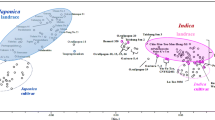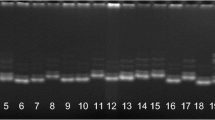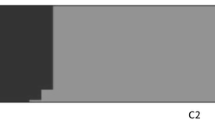Abstract
The archipelago of Indonesia has a long history of rice production across a broad range of rice-growing environments resulting in a diverse array of local Indonesian rice varieties. Although some have been incorporated into modern breeding programs, the vast majority of these landraces remain untapped. To better understand this rich source of genetic diversity we have characterized 330 rice accessions, including 246 Indonesian landraces and 63 Indonesian improved cultivars, using 30 fluorescently-labeled microsatellite markers. The landraces were selected across 21 provinces and include representatives of the classical subpopulations of cere, bulu, and gundil rices. A total of 394 alleles were detected at the 30 simple sequence repeat loci, with an average number of 13 alleles per locus across all accessions, and an average polymorphism information content value of 0.66. Genetic diversity analysis characterized the Indonesian landraces as 68% indica and 32% tropical japonica, with an indica gene diversity of 0.53 and a tropical japonica gene diversity of 0.56, and a F st of 0.38 between the two groups. All of the improved varieties sampled were indica, and had an average gene diversity of 0.46. A set of high quality Indonesian varieties, including Rojolele, formed a separate cluster within the tropical japonicas. This germplasm presents a valuable source of diversity for future breeding and association mapping efforts.



Similar content being viewed by others
References
Blair MW, Hedetale V, McCouch SR (2002) Fluorescent-labeled microsatellite panels useful for detecting allelic diversity in cultivated rice (Oryza sativa L.). Theor Appl Genet 105:449–457
Brown AHD, Feldman MW (1981) Population structure of multilocus associations. Proc Natl Acad Sci USA 78:5913–5916
Cavalli-Sforza LL, Edwards AWF (1967) Phylogenetic analysis: models and estimation procedures. Am J Hum Genet 19:233–257
Cheng CY, Motohashi R, Tsuchimoto S, Fukuta Y, Ohtsubo H, Ohtsubo E (2003) Polyphyletic origin of cultivated rice: based on the interspersion pattern of SINEs. Mol Biol Evol 20:67–75
Coburn JR, Temnykh SV, Paul EM, McCouch SR (2002) Design and application of microsatellite marker panels for semiautomated genotyping of rice (Oryza sativa L.). Crop Sci 42:2092–2099
Falush D, Stephens M, Pritchard JK (2003) Inference of population structure using multilocus genotype data: linked loci and correlated allele frequencies. Genetics 164:1567–1587
Felsenstein J (1985) Confidence limits on phylogenies: an approach using the bootstrap. Evolution 39:783–791
Flint-Garcia SA, Thornsberry JM, Buckler ESt (2003) Structure of linkage disequilibrium in plants. Annu Rev Plant Biol 54:357–374
Flint-Garcia SA, Thuillet AC, Yu J, Pressoir G, Romero SM, Mitchell SE, Doebley J, Kresovich S, Goodman M, Buckler E (2005) Maize association population: a high-resolution platform for quantitative trait locus dissection. Plant J 44:1054–1064
Gabriel SB, Schaffner SF, Nguyen H, Moore JM, Roy J, Blumenstiel B, Higgins J, DeFelice M, Lochner A, Faggart M, Liu-Cordero SN, Rotimi C, Adyemo A, Cooper R, Ward R, Lander ES, Daly MJ, Altshuler D (2002) The structure of haplotype blocks in the human genome. Science 296:2225–2229
Gao LZ, Zhang CH, Chang LP, Jia JZ, Qiu ZE, Dong YS (2005) Microsatellite diversity within Oryza sativa with emphasis on indica–japonica divergence. Genet Res 85:1–14
Garris AJ, Tai TH, Coburn JR, Kresovich S, McCouch S (2005) Genetic structure and diversity in Oryza sativa L. Genetics 169:1631–1638
Glaszmann JC (1988) Geographic pattern of variation among asian native rice cultivars (Oryza-Sativa-L) based on 15 isozyme loci. Genome 30:782–792
Glaszmann JC (1987) Isozymes and classification of asian rice varieties. Theor Appl Genet 74:21–30
Harushima Y, Nakagahra M, Yano M, Sasaki T, Kurata N (2002) Diverse variation of reproductive barriers in three intraspecific rice crosses. Genetics 160:313–322
IRRI (1967) In: Annual report for 1966, International Rice Research Institute (IRRI), Manila, Philippines, p 59–82
Jain S, Jain R., McCouch S. (2004) Genetic analysis of Indian aromatic and quality rice (Oryza sativa L.) germplasm using panels of fluorescently-labeled microsatellite markers. Theor Appl Genet 109:965–977
Khush GS (1997) Origin, dispersal, cultivation and variation of rice. Plant Mol Biol 35:25–34
Khush GS, Brar DS, Virk PS, Tang SX, Malik SS, Busto GA, Lee YT, McNally R, Trinh LN, Jiang Y, Shata MAM (2003) Classifying rice germplasm by isozyme polymorphism and origin of cultivated rice. In IRRI (ed) Discussion Paper No. 46. International Rice Research Institute, Los Banos
Li ZK, Fu BY, Gao YM, Xu JL, Ali J, Lafitte JR, Jiang YZ, Rey JD, Vijayakumar CHM, Maghirang R, Zheng TQ, Zhu LH (2005) Genome-wide introgression lines and their use in genetic and molecular dissection of complex phenotypes in rice (Oryza sativa L.). Plant Mol Biol 59:33–52
Li Z, Rutger JN (2000) Geographic distribution and multilocus organization of isozyme variation of rice (Oryza sativa L.). Theor Appl Genet 101:379–387
Liu K, Muse SV (2005) PowerMarker: Integrated analysis environment for genetic marker data. Bioinformatics 21:2128–2129
Lu H, Redus MA, Coburn JR, Rutger JN, McCouch SR, Tai TH (2004) Population structure and breeding patterns of 145 US rice cultivars based on SSR marker analysis. Crop Sci 45:66–76
Ma J, Bennetzen JL (2004) Rapid recent growth and divergence of rice nuclear genomes. Proc Natl Acad Sci USA 101:12404–12410
Ohta T (1982) Linkage disequilibrium due to random genetic drift in finite subdivided populations. Proc Natl Acad Sci USA 79:1940–1944
Oka HI (1988) Functions and genetic base of reproductive barriers. In Oka HI, (ed) Origin of cultivated rice. Tokyo/Elsevier Science/Japan Scientific Societies Press, Amsterdam, pp 156–159, 181–209
Page RD (1996) TreeView: an application to display phylogenetic trees on personal computers. Comput Mol Biol 12:357–358
Peng S, Cassman KG, Virmani SS, Sheehy J, Khush GS (1999) Yield potential trends of tropical rice since the release of IR8 and the challenge of increasing rice yield potential. Crop Sci 39:1552–1559
Pritchard JK, Stephens M, Donnelly P (2000) Inference of population structure using multilocus genotype data. Genetics 155:945–959
Rohlf F (1997) NTSYS-pc: numerical taxonomy and multivariate analysis system, 2.1 edn. Department of Ecology and Evolution, State University of NY, Stony Brook
Second G (1982) Origin of the genetic diversity of cultivated rice (Oryza spp.): study of the polymorphism scored at 40 isozyme loci. Jpn J Genet 57:25–57
Takahashi N (1997) Differentiation of ecotypes in cultivated rice. In Matsu T, Futsuhara Y, Kikuchi F, Yamaguchi H (eds) Science of the rice plant, vol 3. Genetics, Tokyo, pp 112–118
Tang JB, Xia HA, Cao ML, Zhang XQ, Zeng WY, Hu SN, Tong W, Wang J, Yu J, Yang HM, Zhu LH (2004) A comparison of rice chloroplast genomes. Plant Phys 135:412–420
Tanksley SD, McCouch SR (1997) Seed banks and molecular maps: unlocking genetic potential from the wild. Science 277:1063–1066
Temnykh S, Park WD, Ayres N, Cartinhour S, Hauck N, Lipovich L, Cho YG, Ishii T, McCouch SR (2000) Mapping and genome organization of microsatellite sequences in rice (Oryza sativa L.). Theor Appl Genet 100:697–712
Virk PS, Khush GS, Peng J (2004) Breeding to enhance yield potential of rice at IRRI: the ideotype approach. Int Rice Res Notes 29:5–9
Vitte C, Ishii T, Lamy F, Brar DS, Panaud O (2004) Genomic paleontology provides evidence for two distinct origins of Asian rice (Oryza sativa L.). Mol Genet Genomics 272:504–511
Yang GP, Maroof MAS, Xu CG, Zhang Q, Biyashev RM (1994) Comparative analysis of microsatellite DNA polymorphism in landraces and cultivars of rice. Mol Gen Genet 245:187–194
Yeh FC, Yang RC, Boyle TBJ, Ye ZH, Mao JX (1997) POPGENE, the user-friendly shareware for population genetic analysis. Molecular Biology and Biotechnology Centre, University of Alberta, Canada
Yu SB, Xu WJ, Vijayakumar CHM, Ali J, Fu BY, Xu JL, Jiang YZ, Marghirang R, Domingo J, Aquino C, Virmani SS, Li ZK (2003) Molecular diversity and multilocus organization of the parental lines used in the International Rice Molecular Breeding Program. Theor Appl Genet 108:131–140
Zhu Q, Ge S (2005) Phylogenetic relationships among A-genome species of the genus Oryza revealed by intron sequences of four nuclear genes. New Phytol 167:249–265
Acknowledgments
This material is based upon work supported by the US National Science Foundation under grant no. 0301919 as an International Research Fellowship Program award to M.J.T. We also acknowledge the Indonesian Agency for Agricultural Research and Development for an RPTP 2004 grant to E.M.S. We would also like to thank Dr. Sugiono Moeljopawiro, Dr. M. Herman, and Dr. Sutrisno for hosting M.J.T. in Indonesia, Dr. Ida Hanarida Soemantri for providing access to the Indonesian rice germplasm collection, Matsuma for technical support and Lois Swales for help in formatting this manuscript.
Author information
Authors and Affiliations
Corresponding author
Additional information
Communicated by A. Paterson.
Electronic supplementary material
Rights and permissions
About this article
Cite this article
Thomson, M.J., Septiningsih, E.M., Suwardjo, F. et al. Genetic diversity analysis of traditional and improved Indonesian rice (Oryza sativa L.) germplasm using microsatellite markers. Theor Appl Genet 114, 559–568 (2007). https://doi.org/10.1007/s00122-006-0457-1
Received:
Accepted:
Published:
Issue Date:
DOI: https://doi.org/10.1007/s00122-006-0457-1




